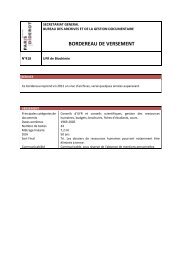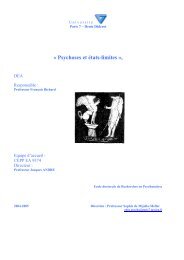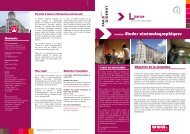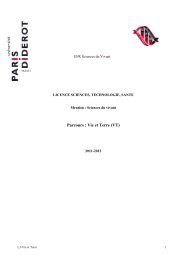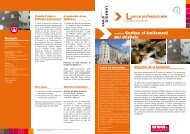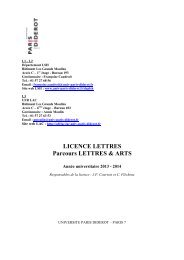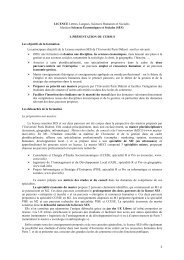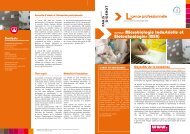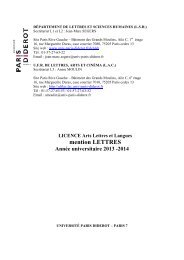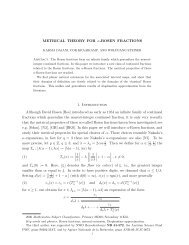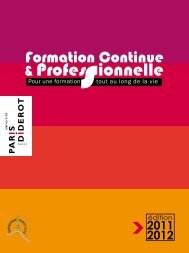Coordinator's names Carole DELPORTE-GALLET Hugues ...
Coordinator's names Carole DELPORTE-GALLET Hugues ...
Coordinator's names Carole DELPORTE-GALLET Hugues ...
You also want an ePaper? Increase the reach of your titles
YUMPU automatically turns print PDFs into web optimized ePapers that Google loves.
2.2 Objectives, originality and/or novelty of the proposal<br />
We have the ambitious project to achieve the reconciliation between the two communities by focusing on<br />
the same class of problems, the yes/no-problems, and establishing the scientific foundations for building up<br />
a consistent theory of computability and complexity for distributed computing.<br />
The main question addressed in this project is the following: is the absence of globally coherent computational<br />
complexity theories covering more than fragments of distributed computing inherent to the field?<br />
One issue is obviously the types of problems located at the core of distributed computing. Tasks like<br />
consensus, leader election, and broadcasting are of very different nature. They are not yes-no problems 2 ,<br />
neither are they minimization problems. Coloring and Minimal Spanning Tree are optimization problems<br />
but we are often more interested in constructing an optimal solution than in verifying the correctness of<br />
a given solution. Still, it makes full sense to analyze the yes-no problems corresponding to checking the<br />
validity of the output of tasks.<br />
Another issue is the power of individual computation. The FLP impossibility result 3 as well as Linial’s<br />
lower bound [25] hold independently from the individual computational power of the involved computing<br />
entities. For instance, the individual power of solving NP-hard problems in constant time would not help<br />
overcoming these limits which are inherent to the fact that computation is distributed.<br />
A third issue is the abundance of models for distributed computing frameworks, from shared memory to<br />
message passing, spanning all kinds of specific network structures (complete graphs, unit-disk graphs, etc.)<br />
and or timing constraints (from complete synchronism to full asynchronism). There are however models,<br />
typically the wait-free model and the LOCAL model, which, though they do not claim to reflect accurately<br />
real distributed computing systems, enable focusing on some core issues.<br />
Despite the above issues, this project seeks to demonstrate that many important notions of Distributed<br />
Computing seem to fit well with standard computational complexity. Distributed Computing should thus<br />
greatly benefit from expressing its main challenges in this standard framework for making them accessible<br />
to a wider audience.<br />
3 Scientific and technical programme, proposal organisation<br />
3.1 Scientific programme, proposal structure<br />
The main purpose of this project is to define the basis for the complexity and the computability of distributed<br />
computing.<br />
First of all, the classical notions of computability in term of, for example Turing machines, do not apply<br />
directly to distributed computing. Distributed computing deals with infinite computations and some models<br />
of computations for distributed protocols (e.g. population protocols [1] or self-stabilizing algorithms [15]) are<br />
defined in terms of convergence (only computations such that eventually the output stabilizes are considered)<br />
and asynchrony in wait-free and fault-tolerant computing are properties on sets of infinite sequences with<br />
some fairness conditions. The FLP impossibility result for the consensus [16] does not depend on the<br />
computability power of the processes, and this result is then very different from the classical undecidability<br />
results with Turing machines.<br />
Concerning complexity problems, distributed computing raises new problems. One of the main point is<br />
here the question of the locality of computations as in the LOCAL [27] or CON GEST models making the<br />
definition of complexity classes relevant for distributed computing necessary.<br />
Nevertheless, even if the classical computability and complexity theory do not apply directly here, it is<br />
clear that most of its methods and tools will give the basis to establish a computational and complexity<br />
theory for distributed computing. Therefore the main approach of this project is to try to use classical tools<br />
2 yes-no problems are generally called decision problems in classical computing theory. They are problems that output yes<br />
or no depending on the inputs of the nodes. A precise definition of yes-no problems in distributed computing is not obvious.<br />
Yes-no problems is the subject of Task 2.<br />
3 FLP result [16] is a fundamental result in fault-tolerant distributed computing that proves the impossibility of consensus<br />
when at least one process may crash.<br />
6



